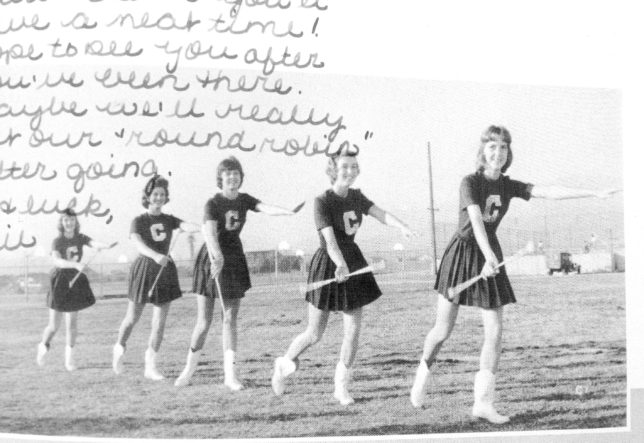Penny University – a week after the 2016 election
We need to connect. We need to talk together.
— a Penny U participant
Co-organizer Edward Wolcher and I have been hosting Penny U at Town Hall since fall 2014. We’ve generally had 20-30 people show up for the conversations that take place around small tables. Penny U has been a place to talk, not just listen. The discussion has been lively, and people leave energized. But, Town Hall sold over 250 tickets for the Penny U on November 15 when the topic was, “Post-election: What’s next?” Our retiring U.S. Congressman Jim McDermott was definitely a powerful draw. He helped set the stage with a few remarks during the introductory part of the program and received a standing ovation for his long service.
Among other things, Jim told us that we all have to speak out, and we have to organize. “If we don’t speak up for other people and take on these issues, the hate will continue to seep into our society.”
He went on to say:
We all want a nice quiet life; we don’t want to get involved in all this. But, folks, there’s no way out of this, you don’t have a choice. The fact that you came out tonight means that you can be a choir that goes out and tells the rest of the city. We have to come together as a community around the issue of the common good. What’s good for Jim McDermott and his family has got to be good for everybody else in this whole city, and in this whole state, and this whole country. But it has to start somewhere and it can start with something like this Town Hall. We each have a responsibility to do our part. 250 people are a lot of people to be out there, churning and stirring people up. As Benjamin Franklin said, “If we don’t stick together, we will hang separately.”
He also quoted Frodo from J.R.R. Tolkien’s The Lord of the Rings: “All we have to do is to decide what to do with the time that is given to us.”
While many people in the hall came specifically to hear Jim speak, at least 200 people stayed for the conversations that followed. After Jim left to catch a red-eye back to the other Washington (something he hadn’t done for years, but did to be with us), we all moved downstairs from the Great Hall and began talking together around small tables or in small circles of chairs in all parts of the lobby.
From the Great Hall stage Edward and I had posed two questions to prompt conversation:
- Was this election a symptom of something fundamentally broken in U.S. politics, in our economy, in our basic social structures?
- Now that the election is over: what should concerned, engaged citizens do?
Most conversations were among four to six people, a few tables held more. As part of his opening remarks, Edward encouraged everyone to sit with people they didn’t know. From a quick glance around the lobby, I noticed that couples I knew had indeed split up and sat at different tables. Generations mixed. One person in each group volunteered to take notes.
The energy around the tables was palpable, and many people told me afterward how grateful they were to have had this chance to talk. One man said, “This isn’t what I expected, but sign me up.” Scattered through the notes, I found comments like, “It’s time to stand up and engage physically.” Or, “This is new to me, I want to be helping more.” “Complacency must end!” “We need to re-energize; it’s time to become an activist again.” “We can’t get used to this!” The chance to connect, face-to-face, mattered.
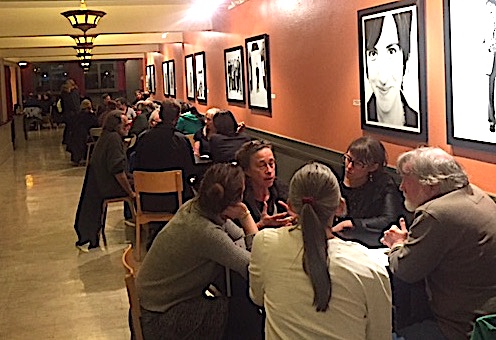
Summary report
We collected over 30 sets of notes from the conversation. In addition to being surprised at how legible and long most of them were, I was struck by the fact that, with a few exceptions, the focus was on the second question, not the first – on what we should do. Because interest was so high, Edward, Town Hall, and I scheduled another Penny U for early December to build on the desire to to find practical steps that we, as individuals and as a community, can take to organize around the concerns that surfaced. (see “So many ideas. So much to do!” for more about the December meeting.)
Following is a report on what happened at Penny U in November. There is no way to adequately summarize all the observations, insights, and ideas that were captured in over 60 pages of hand-written notes. The report feels like a shorthand outline that only skims the surface. In most cases, comments are direct transcriptions from the notes. (If you’d rather read the summary as a pdf, it’s available here.)
In part because the upcoming Penny U focuses on practical steps we can take, the summary sticks primarily to the question of what we should do. Our aim is that the summary will provide a useful beginning point for the small groups that will form that day. Comments have been grouped in two ways: specific areas of focus for our action and the kinds of actions we can take regardless of the specific focus. None of them are insignificant, they all matter. It’s also important to understand that no single one of us can cover all the bases. Many comments in the notes echoed this one: “Pick one issue and do it really hard.” Or, as Barbara Kingsolver has said,
Trump changed everything. Now everything counts.*
««««««•»»»»»»
Penny U summary: table conversations
What should a concerned citizen do?
AREAS OF FOCUS / SPHERES OF ACTION
Hold the media accountable / understand the news we consume
- Use difference sources of news, “choose your news”
- Get outside own technological bubble; read The Big Sort, learn how much we’re “sorted”
- Figure out how to fight inaccurate/false information, fight fake news
- Identify biases in news sources
- Learn how money and advertising control the news
- Support nonprofit journalism, support free media, subscribe to a paper
- Don’t let media “normalize” Trump, it’s unacceptable
- Learn what’s going on internationally
- Be aware of how social media filters the news
- Get after media to broadcast positive messages & education
- How can we change the national conversation?
Protect individual and civil rights/fight racism, sexism, LGBTQ bashing, and more
- Help people feel safe
- Stand up for/with people of color, LGBTQ
- How do we address prejudice & hatred? How do we respond to bullies?
- Protest against policies that promote hate & violate rights
- Fight white supremacy
- Address anti-choice movement
- Daily acts of kindness to people who look different from you.
- How do we have meaningful conversation about race with all sides heard & respected?
- Can we use our privilege to give others a place at the table?
- Share truths & articles on racism
- Intentionally engage diverse people
- Provide sponsorship & funding to immigrants
- Fight misogyny, classism
- Create a venue for people’s anger
- Speak up whenever there’s a hate crime
- Speak up if someone is being harassed
Build understanding & develop conversation with the “other side”
- Build relationships with people, not just around politics
- Bridge gap between eastern and western Washington, reach out, ask their views
- Speak about our values, find empathy
- Read books written for “the other side.” Connect with family/fiscal conservatives. How?
- How can we engage people who voted for Trump? Read The Art of the Deal
- Don’t demonize Trump supporters, target his team/administration.
- Make ourselves open to the “other side,” allow ourselves to be uncomfortable
- Can we have non-emotional conversations, with people holding opposite opinions?
- Listen deeply, not to advance own agenda but to understand
- What are culturally relevant ways to approach them?
- Hold as many of these conversations face-to-face as possible
- Understand the role of economics, and the needs of the economically disenfranchised; since the 1980s there has been mass impoverishment
- Listen to other viewpoints, have conversations with people you wouldn’t usually speak to
- Onus is on us to start the conversation. Listen to labor
- Learn source of the fear that defined this election, learn about their pain, anger, mistrust
- Ask “why?” We need to have these discussions.
- Understand the “enemy” – the fear, disenfranchisement, longing for the way things were.
- Understand the root causes of fear. Share your fear for what may happen.
- Volunteering time can often further understanding better than direct, abrupt conversation
- Connect across all lines, identify common ground, get out of our bubble. How?
- Work against class divisions
- Get a pen pal in a red state, tell your story
Review, revise, change the U.S. voting & election process
- Work to change the electoral college system. It is a big part of the problem.
- Change the electoral college process at a state level
- Why don’t more people vote? Work to get more people to vote next time. Recruit youth
- Fight gerrymandering. The 2018 election is crucial for redistricting.
- The National Popular Vote needs to pass
- Increase understanding of our political & electoral process–example, ex-cons can vote
- Hold forums for candidates to express views
- Advocate for rank voting
- Fight Citizens United
- Ask, are we still a democracy? Audit our system.
- Set term limits
- Fight for voters’ rights
Bolster the Democratic Party and communicate with current legislative bodies
- Support & communicate with our own officials, representatives
- Become active in the local Democratic Party to refocus on labor rights, access to education, economic opportunity, tax fairness; attend district meetings
- Reshape the Democratic Party, co-opt the party’s need to rebrand itself
- Crowdsource the research that politicians need.
- We need a dynamic “change” candidate
- Advocate for legislation to reduce economic inequality & to improve access to education
- Write your member of congress, personally
- Talk to state legislators, call and write. Do we want them to stalemate on specific issues?
- Run for office
- Support Democrats’ efforts to raise minimum wage
- Work on the NEXT election in two years.
- We need to transform Congress
Organize to change public policy from outside the current party structure
- Traditional political action alone is not sufficient.
- Two-party system is tribal. It doesn’t facilitate coalition-building
- The two-party system silences anyone not part of the system
- Why do we have essentially only two parties? Consider third parties.
Educate ourselves/improve our education system
- Understand U.S. politics first
- Engage young people in high school
- “Democracy is only as good as an educated citizenry”
- Broaden our historical narrative
- Increase education on policy and politics
- Learn how to politely debate around difficult conversations
- Also educate elders and parents
- Make presentations at schools, and provide resources to teachers
- Teach children about tolerance, to be tolerant
- Bring back civics as a required course
Be part of actions around specific issues. Many causes are interconnected.
- Protect the environment, address climate change
- Environmental degradation is an assault on human rights
- Immigration
- Abortion rights
Hold face-to-face conversations within & between specific efforts
- Talk with each other. “If we can’t talk to each other, nothing can get accomplished”
- Stoke the fire with like-minded individuals. Host political meet-ups, Swedish “study circle.” Include young children. Bring dialogue back to America.
- Help “move fear into political courage”
- Get “offline” conversations going, create safe spaces for dissent
- Engage in nuanced conversations
- Have facilitated conversations with people on the other side of the aisle
- Our fundamental values & institutions will decay if we can’t have discourse
Help coordinate many different efforts and a more cohesive movement
- Develop overall coordination of many different efforts
- Expand the choir, bring more people to activism, we need action on multiple fronts
- “Politicize” liberals rather than convert Trump supporters
- Figure out how to have a more cohesive movement
- How do we make this movement “smarter”? and more disciplined
- How do we engage as many people as possible & still maintain cohesion?
- What are the big ideas that could be shared?
- We haven’t developed a message. We need to be consistent. Focus & sharpen?
- Learn basic strategies of movement building
- Name the commonalities; tension among us is not pathological
- Could this be a time of optimism?
- How can a progressive umbrella be inclusive going forward?
- We need goals & vision, we need more critical thinking and respectful deliberation
- Keep attending events like this, keep hosting them, bring young people to them
- Create a digest or resource for “what to do”
- We should learn how the 30-year-long, right-wing, conservative movement got strong; it was a long-term, disciplined, multi-pronged strategy.
- Expect this to be a 15-year fight
- Engage in Transformational Activism”
- Rebuild the public sector / civil society / sense of the common good.
KINDS OF ACTION regardless of the specific focus or sphere of action
Protest – In one form or another, this was mentioned a lot
- Demonstrations, boycotts, rallies, songs
- Piggy-back on existing forms of congregation (churches, schools, etc.)
- Peacefully make it known that hate is not acceptable
- Turn a march into a message
- Show up, just show up, bring friends
- Speak up
- Backup protestors in simple ways (I’ll bail you out, feed your cat)
- Boycott companies that support Trump (list by Shawn King)
- Movements, like Occupy, need to be more organized
- Pete Seeger
Donate – Came up over and over as a response
- “When in doubt, donate”
- Donate to organizations and causes we believe in
- Host events to raise money for groups that are helping people
- Host a “booth fair” for these organizations.
Volunteer – Volunteering came up repeatedly as a way to respond
- Find one cause/fight, and put yourself behind it. (said in various ways)
- We each need to focus on our cause.
Organize – at neighborhood level, at national level, internationally
- Such as, in neighborhoods meet neighbors, organize block watches, coordinate donations, politicize little libraries
Take personal action – Many items under specific causes are also personal actions
- Question your previous assumptions
- Protect your online identity
- Put a family member on your bank account in case you’re arrested protesting
- Look at our own “shadow self,” “what is my inner D Trump?”
- Take little actions, something small and doable
- Don’t slide back into complacency
- Become activist again
- Fuel yourself with positive, accurate information. Confrontation is not the answer.
- Watch your conversations online; there’s no anonymity there
- Vote, participate
- We can’t feel it’s so bad that we can give up.
- Stay focused, fight personal sense of hopelessness.
- Figure out what will sustain you in your activism
««««««•»»»»»»
* Barbara Kingsolver, “Donald Trump Changed Everything. Now Everything Counts,” The Guardian, November 23, 2016.
![]()
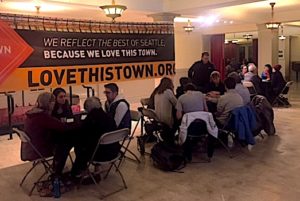
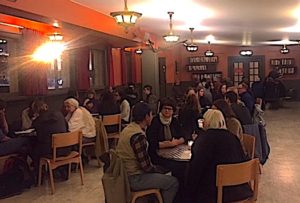

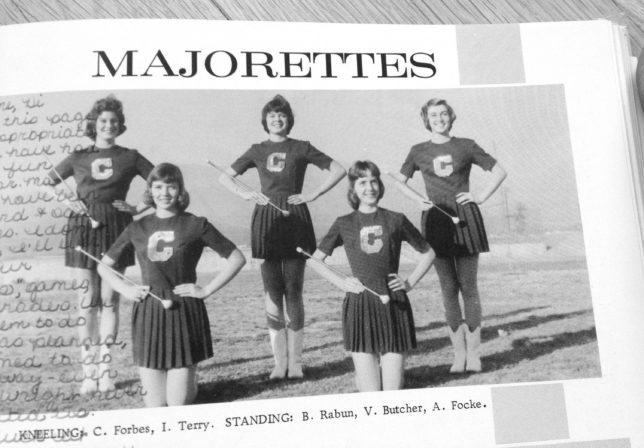 Between age six and college, though, my baton inspired an early instance of what I mean by “making it up.” Perhaps out of a need to find friends in a new high school, I gradually convinced a group of girls to twirl with me. I don’t remember if we actually took lessons or if they had also been in twirling classes when younger or if we simply drew on what I could remember. But I made sure that we had regular practices, that we made up and learned “routines,” found recorded music to march to, created outfits, and eventually convinced the school that it needed marching majorettes at football games. Even though our school had no band, the five of us marched in patterns to recorded music, twirling and tossing our batons into the air at halftime. It was one of the things I was remembered for at my 50th high school reunion.
Between age six and college, though, my baton inspired an early instance of what I mean by “making it up.” Perhaps out of a need to find friends in a new high school, I gradually convinced a group of girls to twirl with me. I don’t remember if we actually took lessons or if they had also been in twirling classes when younger or if we simply drew on what I could remember. But I made sure that we had regular practices, that we made up and learned “routines,” found recorded music to march to, created outfits, and eventually convinced the school that it needed marching majorettes at football games. Even though our school had no band, the five of us marched in patterns to recorded music, twirling and tossing our batons into the air at halftime. It was one of the things I was remembered for at my 50th high school reunion.